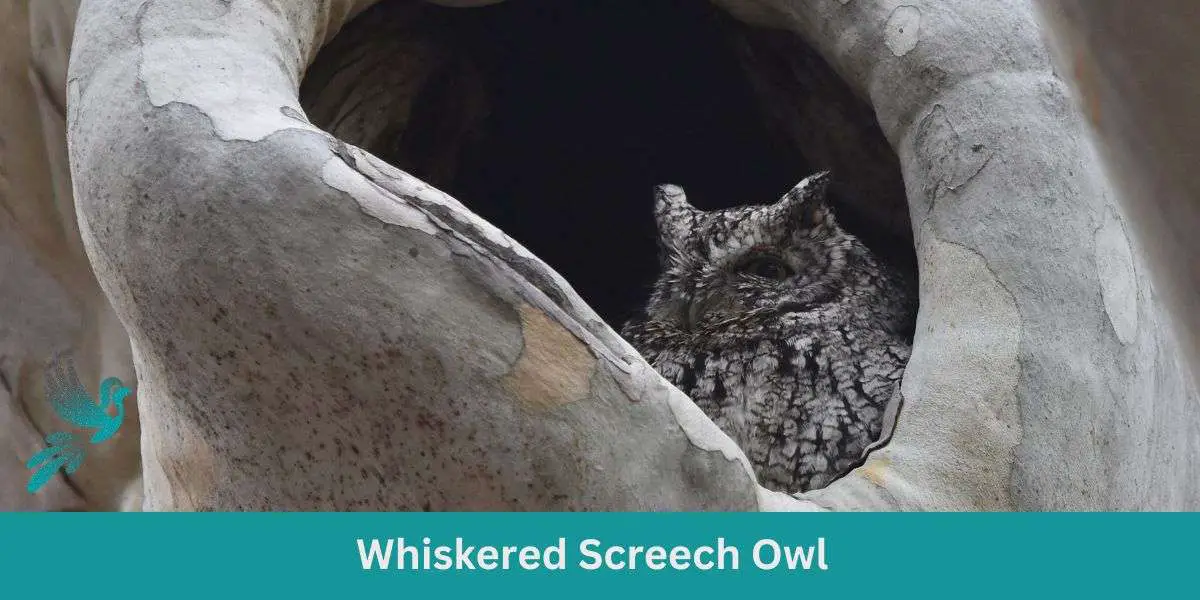Hidden among the dense foliage, with a call as mysterious as its name, the Whiskered Screech Owl is a lesser-known jewel of the owl world. Small yet fierce, this nocturnal raptor is named for its distinct ‘whiskered’ appearance.
Embark on an explorative journey with us to get to know the intricacies of the Whiskered Screech Owl.
Whiskered Screech-Owl
The Whiskered Screech-Owl is a fascinating species of owl that can be found in parts of the United States. In this article, we will explore various aspects of this owl, including its description, habitat, feeding behavior, and more.
The Whiskered Screech-Owl, scientifically known as Megascops trichopsis, is a relatively small owl, measuring about 7-8 inches in length. It has a rounded head, large yellow eyes, and distinct facial whiskers, which give it its name. Its plumage varies, but it typically has grayish-brown feathers with intricate patterns that help it blend into its surroundings.
- Size and Build: A petite raptor, measuring about 8.5 inches in length with a wingspan around 20 inches.
- Plumage: Dark gray to brown with streaks and spots; facial ‘whiskers’ give it its unique name.
- Eyes: Bright yellow eyes that peer intently from the depths of its facial disk.
The Whiskered Screech-Owl belongs to the family Strigidae, commonly known as the owl family. This family includes various species of owls found around the world. Owls are known for their large eyes, distinct facial features, and nocturnal hunting behavior. They play a crucial role in ecosystems by controlling populations of small mammals and insects.
Habitat
- Preferred Habitats: Favors dense montane forests and canyons.
- Distribution: Native to the mountainous regions of Southeastern Arizona, New Mexico, and stretches into Central America.
The Whiskered Screech-Owl can be found in a variety of habitats, including canyons, pine-oak woods, oaks, and sycamores. It prefers areas with relatively dense, broad-leaved oaks, either in pure stands or mixed woodland with pines, usually above 5000 feet.
In Arizona canyons, it is often found in groves of sycamores next to oak woodland. This owl is also commonly found in oak woodlands in mountains near the Mexican border.
The Whiskered Screech-Owl is a permanent resident in its range. It does not undertake long-distance migration like some other bird species. Instead, it remains in its preferred habitat year-round, adapting to the changes in food availability and weather conditions that may occur throughout the year.
Feeding Behavior
- Primary Diet: Primarily feeds on insects and spiders; occasionally will take smaller vertebrates.
- Hunting Methods: Nocturnal hunter, maneuvering skillfully through trees to catch prey.
The Whiskered Screech-Owl is a nocturnal hunter, primarily hunting at dusk and throughout the night. It hunts by watching from a perch and then making short flights to take prey from foliage or the ground. It may fly back and forth or hover among vegetation to capture insects.
The Whiskered Screech-Owl primarily feeds on large insects such as caterpillars, beetles, moths, crickets, and katydids. It also consumes other arthropods, including centipedes and scorpions. Occasionally, it may prey on small rodents. The diet of this owl is important in controlling populations of these prey species, contributing to the balance of ecosystems.
This owl primarily captures its prey with its feet. It mainly feeds on large insects such as caterpillars, beetles, moths, crickets, and katydids. It may also consume other arthropods, including centipedes and scorpions. In some cases, it may even eat small rodents.
Nesting
The breeding behavior of the Whiskered Screech-Owl is not well understood. Male owls defend their breeding territories by singing at night and may vigorously attack intruding males. Mated pairs engage in duet calling, nibble at each other’s bills, and preen each other’s feathers.
The nest sites of this owl are typically cavities in trees, such as abandoned woodpecker holes or natural hollows. These nests are often located 10-30 feet above the ground.
The Whiskered Screech-Owl typically lays 3 eggs, although occasionally it may lay 4 eggs. The eggs are white in color.Both parents likely participate in bringing food to the young owls.
Conservation Status
The Whiskered Screech-Owl is considered locally common in its limited range in the United States. Its population appears to be stable, and it is not currently listed as a species of concern.
However, like many other owl species, it faces threats such as habitat loss and degradation. Conservation efforts are important in maintaining its population and protecting its habitat.
Songs and Calls
The songs and calls of the Whiskered Screech-Owl are distinctive and easily recognizable. Its vocalizations consist of a series of low whistles in a Morse code-like pattern, such as “hoo-hoo hooo hoo, hoo-hoo hooo hoo,” repeated multiple times.
It also produces a rapid “hoohoohoohoo” call. These vocalizations serve various purposes, including communication between individuals and territorial defense.



Leave a Reply
You must be logged in to post a comment.